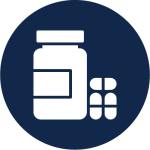Hazardous Chemicals
- the oral LD50 for albino rats is less than 50 mg/kg or
- the topical LD50 for albino rabbits is less than 200 mg/kg or
- the LC50 in albino rats is less than 200 ppm for one hour.
Labels
- listed as a known or reasonably anticipated human carcinogen in the biennial Report on Carcinogens published by the National Toxicology Program
- listed as carcinogenic to humans (Group 1), probably carcinogenic to humans (Group 2A), or possibly carcinogenic to humans (Group 2B) by the International Agency for Research on Cancer (IARC)
- regulated by OSHA as a carcinogen
Labels
Use insulated gloves when handling dry ice. Add dry ice slowly to the liquid portion of the cooling bath to avoid foaming over. Avoid lowering your head into a dry ice chest. Carbon dioxide is heavier than air, and suffocation can result. Do not store dry ice or liquid nitrogen in walk-in cold rooms. Carbon dioxide or nitrogen can displace and thus lower the oxygen concentration in enclosed spaces.
For more information, refer to Appendix 3-B of the Lab Safety Manual (Cryogenic Hazards).
Fact Sheets
Labels
 Reproductive toxins are defined by the OSHA Laboratory Standard as substances that cause chromosomal damage (mutagens) and/or substances with lethal or teratogenic (malformation) effects on fetuses. These can include chemicals, biologicals, and radioactive materials. Chapter 8 of the Laboratory Safety Manual outlines the proper precautions, postings, procedures and controls when working with reproductive hazards.
Reproductive toxins are defined by the OSHA Laboratory Standard as substances that cause chromosomal damage (mutagens) and/or substances with lethal or teratogenic (malformation) effects on fetuses. These can include chemicals, biologicals, and radioactive materials. Chapter 8 of the Laboratory Safety Manual outlines the proper precautions, postings, procedures and controls when working with reproductive hazards.
Examples of reproductive toxins commonly found in laboratories include:
- 1,3-Butadiene
- Arsenic
- Benzene
- Cadmium
- Carbon disulfide
- Dibromochoropropane
- Ethylene dibromide
- Ethylene glycol monomethyl (and ethyl) ethers
- Ethylene oxide
- Ethylene thiourea
- Fluorouracil (5-FU)
- Ionizing radiation
- Lead
- Mercury compounds
- Polychlorinated biphenols (PCBs)
- Tamoxifen
- Toluene
- Urethane
UNC-Chapel Hill is committed to providing additional protection for the conceptus and to establish specific procedures to protect pregnant employees. Review Chapter 8 of the Laboratory Safety Manual for more information regarding the University’s Conceptus Protection Program. If you wish to take advantage of the program, contact EHS as soon as possible after determining or contemplating pregnancy.




